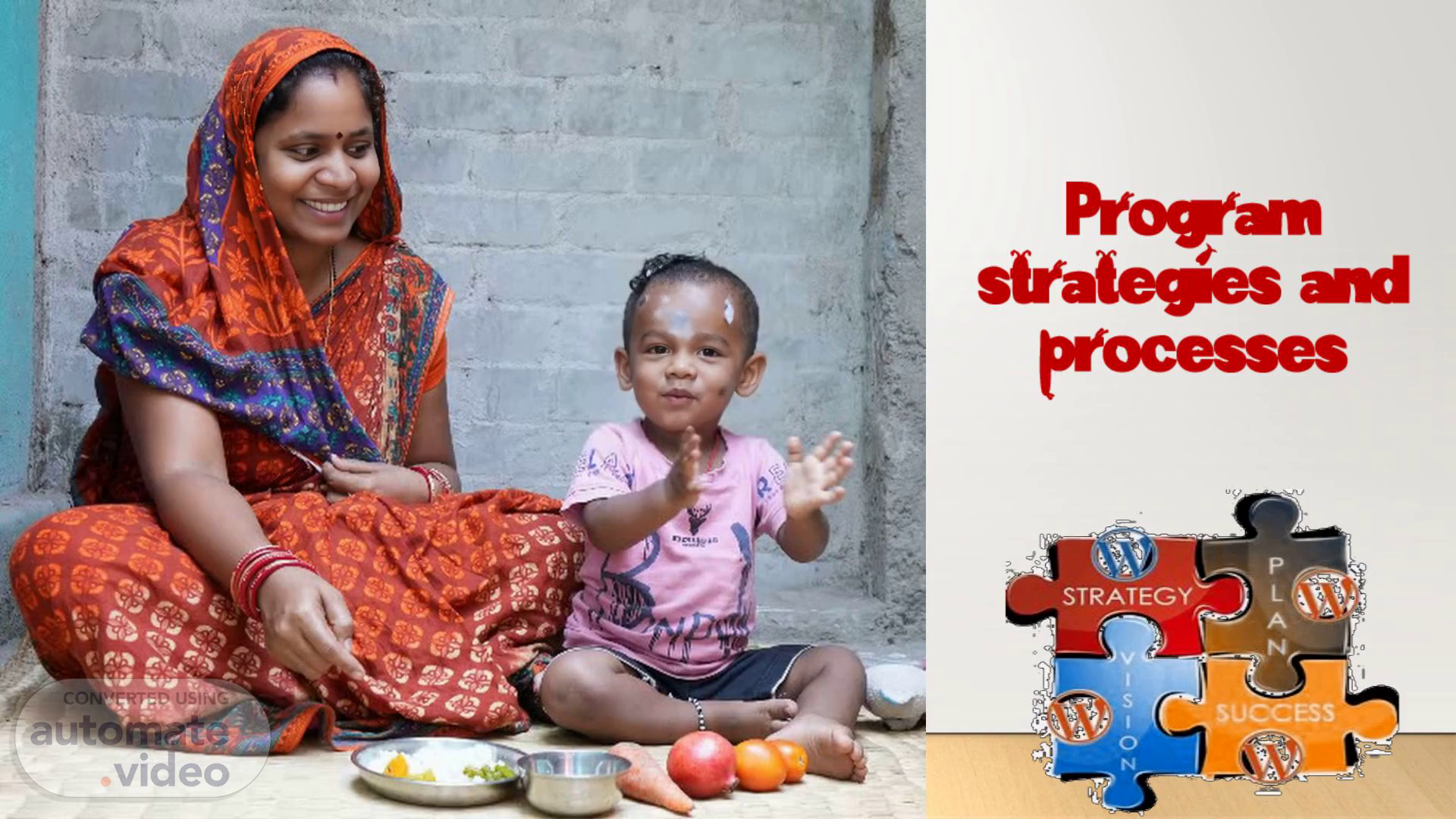Scene 1 (0s)
Program strategies and processes. A person and child sitting on a mat Description automatically generated.
Scene 2 (26s)
[Audio] We are here to discuss Program Strategies and Processes aiming to understand their objectives and models as well as their standard operating procedures and reporting. This will give us a better understanding of the monitoring and reporting process. We'll focus on the project strategy the implementation plan the monitoring and reporting process the project framework the standard operating procedures and the reporting strategy. At the conclusion attendees should have a clearer understanding of the program strategy implementation plan monitoring and reporting process. Inputs to this program include the project framework the sops and the reporting strategy. We will go over the program strategy how it will be monitored and which reporting format is used so that we can develop a clearer operating process..
Scene 3 (1m 14s)
[Audio] We will be discussing the program strategies and processes of scaling to fourteen districts looking at ways to serve seventy percent of populations with five sectors and thirty percent of the population with five sectors. Options such as intensive one-on-one family meetings and intensive one-to-group family meetings will be explored to increase our reach in a more efficient and effective way. Let's begin to expand on these ideas..
Scene 4 (1m 16s)
The programe strategically planned to implement the programme in different category of areas or say zones. These three zones are coastal, urban/peri-urban and Hilly Crescent areas. In the pilot phase the program focuses on utilizing strategies and processes centered around in these three zones by implementing in two selected districts of Odisha states. In the map shown here you can see both the districts highlighted. Puri district is choosen to to maximize our efforts in achieving the best outcomes for two zones i.e. Urban & Coastal where is Debagarh district is choosen for Hilly Crescent.
Scene 5 (1m 41s)
[Audio] The data table shows that there are 2779 children aged from 0 to 3 years old from the chosen districts of Deogarh and Puri with 1462 being boys and 1337 being girls. 489 children live in Intensive Areas while the other 2290 reside in Non-Intensive Areas. These figures can enable us to identify which areas to prioritize in order to improve the health and wellbeing of the young children in these districts..
Scene 6 (2m 15s)
[Audio] We are discussing a slide regarding the strategies and processes we use to target parents of 0-3-year-olds Anganwadi workers and community members on Early Child Development and Responsive Caregiving. Pre and post-training evaluations are conducted to measure knowledge and understanding development; additionally regular on-job monitoring is done with the parents of 0-3-years-olds to ensure quality sessions. Community sensitization sessions are conducted to motivate the use of home kits and to increase attendance at the weekly sessions..
Scene 7 (2m 51s)
[Audio] Aama Kuni Pilaa program is aimed at increasing capacity and creating community consciousness. Every week facilitators will go to homes for individual visits during which they will have a discussion and show a video. On a monthly basis the facilitators will also be engaging the public through activities and local press. The program further provides capacity building for field personnel and community members and holds Father’s Clubs and Family Meetings fortnightly. All of these efforts are meant to elevate the knowledge of positive parenting methods and fortify the family unit..
Scene 8 (3m 43s)
[Audio] Our presentation is about program strategies and processes. During weekly home visits field staff will show videos with key messages and conduct activities adapted to the area's context. Additionally fathers and mothers will be enrolled in fortnightly clubs and taken through enjoyable activities with their children with champion fathers and mothers being identified. To reach a larger audience we will organise special days stalls key message posters and banners and participate in festivals and fairs. Furthermore to promote capacity building trainings will be provided for A-W-W CDPOs and Supervisors on the importance of early years the role of caregivers positive parenting strategies and other engagement strategies. During the pilot phase Regional Coordinators will support A-W-W-S during home visits and group meetings. We are confident that these strategies and processes will help us reach our goals..
Scene 9 (4m 44s)
[Audio] I would like to discuss our program strategies and processes. We have started rolling out in two sectors of Deogarh and Puri which will include A-W-W trainings LS and C-D-P-O trainings. After the piloting in these two districts we will amend the content accordingly before expanding to a district level. To culminate the roll out we have planned a formative dissemination and I-E-C design workshop content development training module and additional activities which will span from February to December 2024..
Scene 10 (5m 18s)
[Audio] This slide is about program strategies and processes related to A-W-W visits LS visits and C-D-P-O visits. For A-W-W visits there is a home visit to all intensive families once a week and meetings with both intensive and non-intensive areas once a fortnight. Additionally there is counselling sessions in V-H-S-N-D for targeted families and 6 father's meetings. LS visits involve visiting all children under 3 years old at 20%. Lastly CDPO visits are sector-level meetings to review and analyse visit findings. All of these strategies and processes are essential for the program's success..
Scene 11 (5m 59s)
[Audio] We need to gather data and information from all departments and analyze it in order to keep track of how our programs are progressing. Different formats can be used to do this including surveys online forms spreadsheets and more. Choosing the most appropriate format requires weighing the advantages and disadvantages of each..
Scene 12 (6m 19s)
CAN!.
